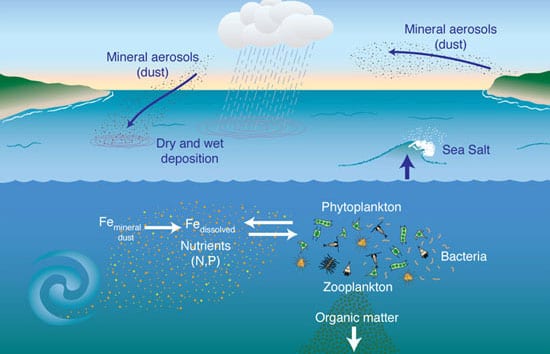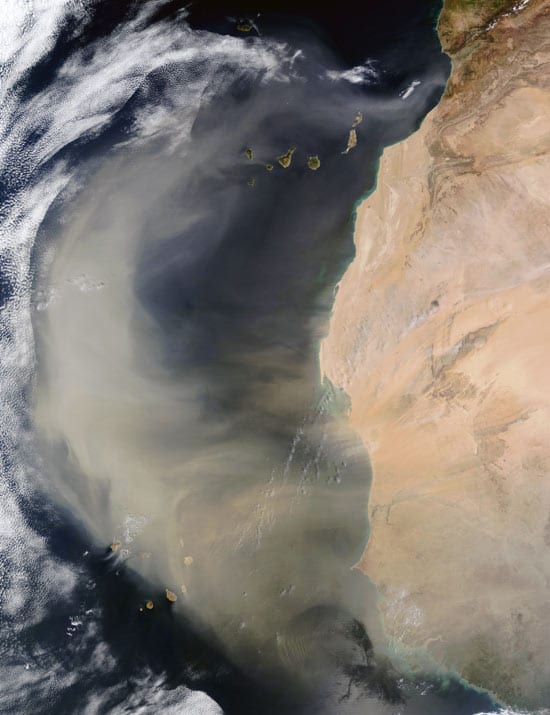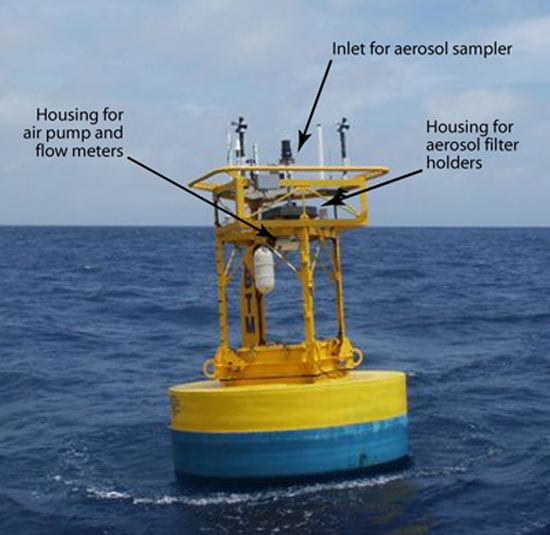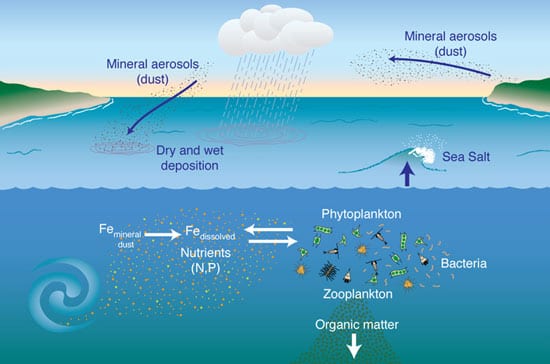
Dust Busters for the Oceans
A new instrument seeks answers that are blowing in the wind
Like most living things, microscopic marine plants need iron and other minerals to live and grow. On land, soil provides a ubiquitous source of minerals, but how do essential nutrients get into vast watery stretches of the open ocean?
The question has long mystified oceanographers. According to one theory, large swirling currents, called eddies, pump nutrients from the depths up toward the sunlit surface, giving phytoplankton the ingredients they need to flourish. But a larger source of iron may be dust storms, which blow huge quantities of mineral-rich soil particles (called Aeolian dust) out to sea, particularly from desert regions in Africa and Asia.
Until now, scientists investigating the latter theory have been stymied by an inability to measure when, where, and how much dust falls into the oceans, said Ed Sholkovitz, a marine geochemist at Woods Hole Oceanographic Institution (WHOI). They have had to rely on dust samples collected on islands.
To remedy this situation, Sholkovitz teamed with three WHOI engineers—Geoff Allsup, David Hosom, and Mike Purcell—who collectively call themselves the “Dust Busters.” They designed a device, mounted atop a moored buoy, that collects wind-blown particles in the open ocean. Unlike islands, which aren’t portable, buoys can be placed in scientifically strategic locales.
The heart of their device is a motorized carousel that rotates 24 dust-collecting filters under a small intake opening. As air passes through the opening, the filters catch samples of windborne particles, which are chemically analyzed back at WHOI.
The particle sampler had to be rugged and watertight to survive months at sea. Software ran the device automatically, coordinating it with meteorological instruments on the buoy to pause sampling when high waves or winds might clog the filters with sea spray.
The Dust Busters collaborated with Peter Sedwick, a marine geochemist at the Bermuda Biological Station for Research, to test their particle sampler from May to September 2004 on a buoy moored off Bermuda. The scientists said the instrument successfully captured dust throughout the summer, including pulses of brown-yellow particles from two large African dust storms in June and August. They reported their findings in an article in press in the journal Deep-Sea Research.
The instrument’s initial success persuaded the National Science Foundation to fund redeployment of an improved particle sampler in 2007 and 2008. With a grant from the WHOI Access to the Sea Program, Sheri White and Norman Farr, engineers in WHOI’s Applied Ocean Physics and Engineering Department, were enlisted to develop a sensor that can measure and monitor color changes in captured dust (indicating its source) in real time. New two-way communications will let scientists modify sampling procedures in response to natural events.
While the particle sampler monitors the supply side of the question, Sholkovitz’s collaborators, Sedwick and Thomas Church from the University of Delaware, will focus on the demand side: How is iron from continental dust chemically transformed and released in seawater to catalyze blooms of phytoplankton at the base of the marine food chain?
The research will help unravel a fundamental process that fuels life in the ocean.
Slideshow

Slideshow
 An intense dust storm sent a massive plume of dust from the Saharan Desert northwestward over the Atlantic Ocean on March 2, 2003. In this true-color scene, acquired by the Moderate Resolution Imaging Spectroradiometer (MODIS) aboard NASA?s Terra satellite, the thick dust plume (light brown) can be seen blowing westward and then routed northward by strong southerly winds. The plume extends more than 1,000 miles (1,600 kilometers), covering a vast swath of ocean extending from the Cape Verde Islands (lower left), off the coast of Senegal, to the Canary Islands (top center) off the coast of Morocco. (Image courtesy of Jacques Descloitres, MODIS Rapid Response Team, NASA/GSFC)
An intense dust storm sent a massive plume of dust from the Saharan Desert northwestward over the Atlantic Ocean on March 2, 2003. In this true-color scene, acquired by the Moderate Resolution Imaging Spectroradiometer (MODIS) aboard NASA?s Terra satellite, the thick dust plume (light brown) can be seen blowing westward and then routed northward by strong southerly winds. The plume extends more than 1,000 miles (1,600 kilometers), covering a vast swath of ocean extending from the Cape Verde Islands (lower left), off the coast of Senegal, to the Canary Islands (top center) off the coast of Morocco. (Image courtesy of Jacques Descloitres, MODIS Rapid Response Team, NASA/GSFC)- WHOI scientists and engineers designed a device, mounted atop a moored buoy, that collects wind-blown particles in the open ocean. The researchers are investigating how iron and other essential minerals get into the open ocean to fuel blooms of marine life. (Courtesy of Ed Sholkovitz, Woods Hole Oceanographic Institution)
- Dust storms sweep iron-rich particles (mineral aerosols) from the continents into the atmosphere. They fall into, or are rained into, the oceans, where iron dissolves into a form that is used, along with other nutrients such as nitrate (N) and phosphate (P), by phytoplankton and bacteria to live and grow. Small marine animals (zooplankton) eat phytoplankton and bacteria. When they excrete fecal pellets or die, organic matter is transferred to the depths. (Jack Cook, Woods Hole Oceanographic Institution)
Related Articles
Topics
Featured Researchers
See Also
- WHOI's Buoy-Mounted Aerosol Sampler An autonomous instrument to collect windborne particles at the air-sea boundary


